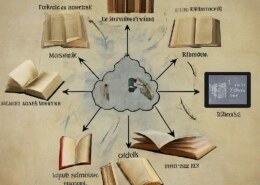What techniques do you use to maintain a healthy balance between technology use and mental well-being?
The advent of digital technology and e-books has profoundly transformed traditional print literature and the reading experience. Here’s an overview of these changes: 1. Accessibility and Distribution Increased Reach: Digital technology has significantly expanded the reach of literature. E-books andRead more
The advent of digital technology and e-books has profoundly transformed traditional print literature and the reading experience. Here’s an overview of these changes:
1. Accessibility and Distribution
- Increased Reach: Digital technology has significantly expanded the reach of literature. E-books and online publications are accessible globally, allowing authors and publishers to reach a wider audience without the geographical constraints of print.
- Instant Access: Readers can instantly access and purchase books from digital platforms, reducing the time and effort needed to acquire new literature. This immediacy contrasts with the often time-consuming process of ordering and waiting for print books.
2. Changing Reading Habits
- Convenience: E-books provide the convenience of carrying multiple books in a single device, such as a tablet or e-reader. This portability has altered reading habits, enabling readers to access their libraries anytime, anywhere.
- Multimedia Integration: Digital platforms often include interactive features such as hyperlinks, multimedia content (videos, audio), and annotations, enhancing the reading experience and providing supplementary material that print books cannot.
3. Economic and Environmental Implications
- Cost Efficiency: E-books often cost less to produce and purchase compared to print books. The elimination of printing, shipping, and storage costs benefits both publishers and consumers.
- Environmental Impact: Digital books reduce the need for paper and physical resources, which can contribute to a decrease in the environmental impact associated with print publishing.
4. Preservation and Innovation
- Archiving and Preservation: Digital technology aids in the preservation of literary works by providing a format that can be easily stored and backed up, ensuring that literature remains accessible over time.
- New Formats and Genres: The digital age has introduced new literary forms such as interactive fiction, serialized content, and self-publishing platforms, allowing for greater innovation and experimentation in literature.
5. Challenges and Considerations
- Digital Divide: Access to digital literature requires technology and internet connectivity, which may exclude certain populations and contribute to the digital divide.
- Sensory Experience: Some readers and critics argue that digital reading lacks the tactile pleasure and aesthetic experience associated with traditional print books, including the feel of paper and the physical presence of a book.


Balancing technology use and mental health involves intentional practices to reduce screen time and enhance well-being: 1. Set Boundaries: Designate tech-free times, such as during meals, before bed, and upon waking. This helps reduce stress and improve sleep quality. 2. Use Tech Mindfully: Be conscRead more
Balancing technology use and mental health involves intentional practices to reduce screen time and enhance well-being:
1. Set Boundaries: Designate tech-free times, such as during meals, before bed, and upon waking. This helps reduce stress and improve sleep quality.
2. Use Tech Mindfully: Be conscious of your online activities. Prioritize meaningful connections and limit mindless scrolling or consumption of negative content.
3. Schedule Breaks: Take regular breaks from screens to rest your eyes and mind. Follow the 20-20-20 rule: every 20 minutes, look at something 20 feet away for 20 seconds.
4. Prioritize In-Person Interactions: Engage in face-to-face conversations and activities to build stronger relationships and combat feelings of isolation.
5. Limit Notifications: Turn off non-essential notifications to reduce distractions and anxiety.
6. Engage in Offline Activities: Cultivate hobbies and interests that don’t involve screens, such as reading, exercise, or outdoor activities.
7. Reflect on Usage: Periodically assess how technology affects your mood and productivity. Make adjustments to enhance your well-being.
By implementing these strategies, you can create a healthier balance between technology use and mental health.
See less